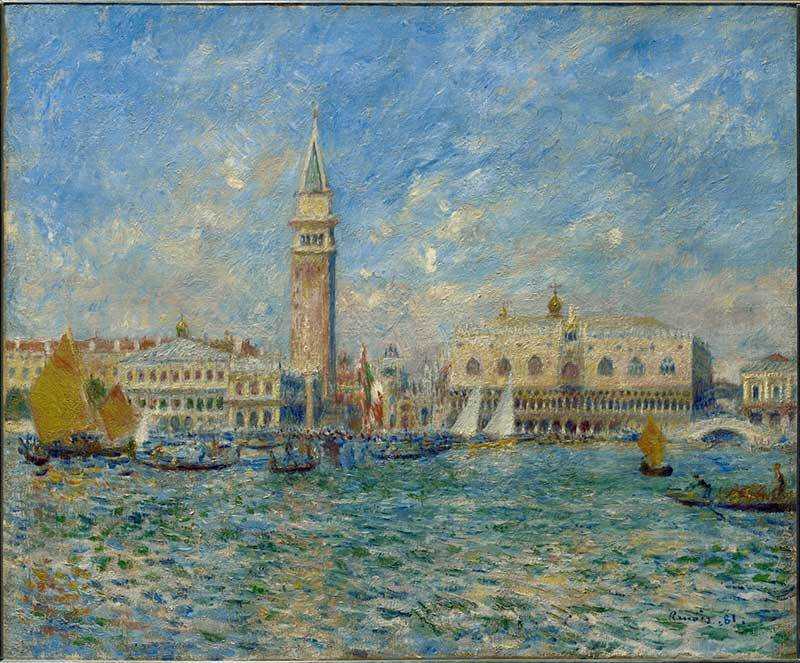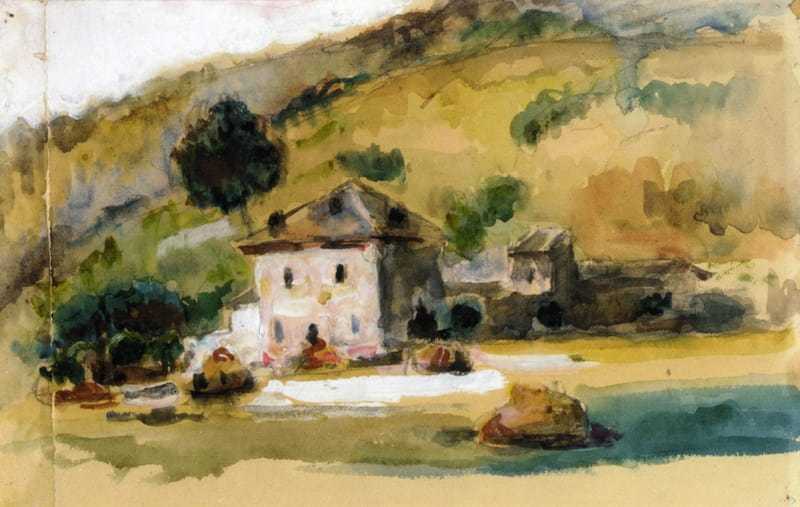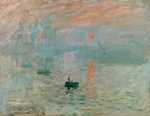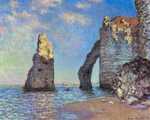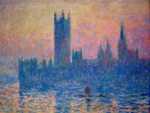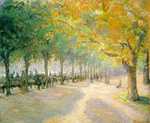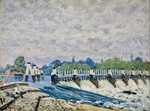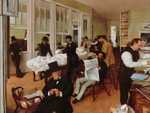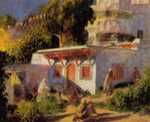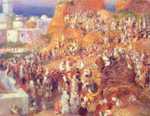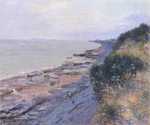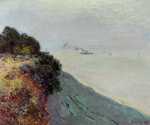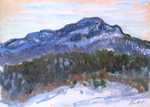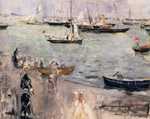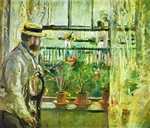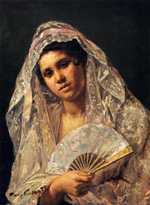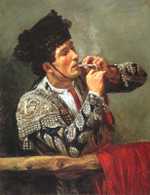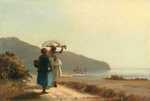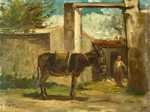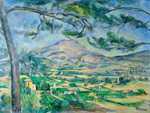1. Normandy, France
A centre for the Impressionist movement, Normandy was the site of countless drawings, sketches and paintings produced by the Impressionists during the late 1800s and early 1900s.
Like the Barbizon School before them, the Impressionists left the confines of Paris and went out into the countryside in order to develop their en plein air painting techniques.
Monet
Monet returned frequently to his hometown of Le Havre in Normandy to paint the harbour and the surrounding coastline. Most memorably, he captured the port of Le Havre from his hotel room in 1873 as the sun came up, producing the painting that eventually gave the Impressionists their name: ‘Impression: Sunrise’.
Together with Eugène Boudin, also born locally, Monet would encourage the other artists of the group to take trips to Normandy. Travelling together, the friends would paint the beauty of the port of Honfleur and nearby Ferme Saint-Simeon. Renoir, Camille Pissarro and Alfred Sisley would set up their easels and wait to observe the changing light as it passed over the Seine estuary.
When evening came and went and there was no light left to paint, the friends would no doubt have gone to a local bar to discuss their work further over plates of hot food and drinks.
Monet also famously painted Rouen Cathedral, found at the centre of Normandy's capital city, on 30 occasions between 1892-3. He also spent three months in Etretat in the early 1883, painting 20 stunning pictures of the beach, the sea and rock formations.
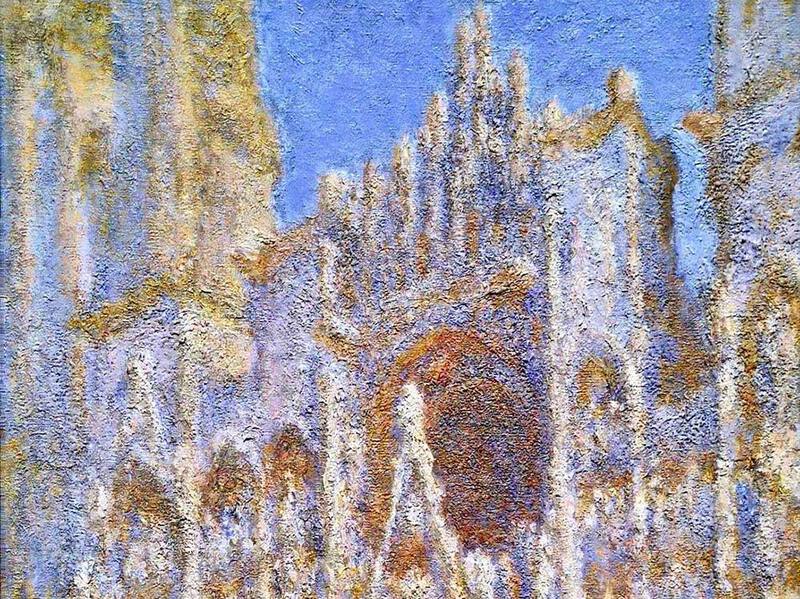
Finally, Monet's home for the final 45 years of his life is found in Normandy. Monet turned his house in Giverny into his own personal Eden, adding fabulous gardens and water lily ponds.
Manet
Edouard Manet also painted in Normandy, most famously his Battle of the Kearsarge and Alamaba (1864). The painting shows how, during the American Civil War, the Union ship USS Kearsarge sunk the Confederate ship CSS Alabama.
Things to do for the tourist
The Normandy coastline is wild, rugged and beautiful. You can see the Normandy beaches (the scene of the D-Day landings), check out the tidal island of Mont Saint-Michel, or soak up the chic seaside resorts of Trouville and Deauville (next to one another and close to the mouth of the Seine). Inland, Rouen is a natural destination, home to the eponymous cathedral (where Joan of Arc was executed in 1431), and any lover of impressionism must have Giverny on their bucket-list.
2. London, UK
Outside of France, one of the best known locations depicted in Impressionist art is London.
Monet, Pissarro and Sisley fled to London during the Franco-Prussian War and the Houses of Parliament and the River Thames served as motifs that Monet returned to time and time again in his paintings.
Monet's visits to London
During numerous visits to London in his later life (1891, 1899, 1900), Monet captured the Houses of Parliament and various bridges over the River Thames under shrouds of mist and fog, relishing in the light effects the weather produced.
In letters to his wife, Alice, Monet described how,
“yesterday there was sun, with an exquisite mist and a splendid sunset; today, rain and fog, to the point that I am writing to you by [electric] light at four in the afternoon, whereas yesterday I was able to work in daylight until almost 6 o’clock.”
He also admitted that, “I find London lovelier to paint each day”. Monet stayed in the Savoy Hotel during his visits, often having numerous canvasses on the go at one time.
Camille Pissarro
Morisot may not have painted London. But Camille Pissarro certainly did during the Prussian War (1870-71). He tended to focus on the suburbs, painting Dulwich (where he painted Lordship Lane Station and Dulwich College), Norwood (painting Fox Hill and All Saints Church) and Crystal Palace (painting The Avenue, Sydenham).
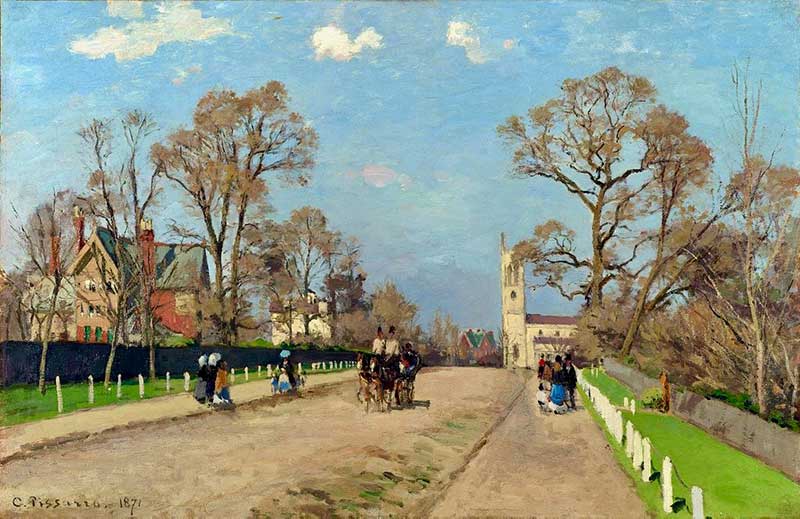
But Pissarro could not sell his paintings. He lamented that
"my paintings do not catch on, not at all".
On the other hand, Pissarro met dealer Paul Durand-Ruel, who put him in contact with Claude Monet - and the two men visited the National Gallery and were hugely impressed and influenced by the works of Turner and Constable.
Pissarro returned to London in 1890, 1892 and 1897 and produced works of Hyde Park (pictured), Kensington Gardens, Chiswick and Kew and Kew Green. The 1890 visit was particularly productive, resulting in 10 canvasses.
Alfred Sisley
Alfred Sisley, the only British impressionist, in fact lived most of his life in France. But he studied business in London between 1857-1861, fled to London during the Prussian War in 1869-70, and returned to London to paint shortly before the first impressionist exhibition in 1874.
Sisley's 1874 visit was his most productive, resulting in 20 canvasses of the Upper Thames near Molesey and Hampton Court. Those paintings--which include Molesey Weir, Bridge at Hampton Court, Regatta at Molesey, Regatta at Hampton Court and Under the Bridge at Hampton Court--have been described by art historian Kenneth Clark as:
"a perfect moment of impressionism."
Berthe Morisot
Along with many other Impressionist artists, Berthe Morisot also visited London. She saw the city in the height of summer, spending many hours exploring the world famous galleries. Morisot and her companion were perhaps a little too keen in their sightseeing efforts, however, as she later wrote,
“we raced around like lost souls”.
One scene that did capture her imagination and stay with her was, “the glimpse of the dome of St. Paul’s through the forest of yellow masts, the whole thing bathed in a golden haze”.
Things to do in London
London is one of the world's most popular tourist attractions. Things to do for the impressionist lover include
- visiting the National Gallery or the Courtauld Gallery, with their impressive collections of impressionist works (including Manet's Music in the Tuileries and Execution of Maximilian, Cezanne's Card Players, some sublime Dancers by Degas and various Monet Water Lilies),
- taking afternoon tea at the Savoy Hotel, and looking out over the Thames in the same way Monet did 130 years ago, and
- walking in the footsteps of Morisot, Pissarro and Sisley by visiting Sir Christopher Wren's St Paul's Cathedral and climbing the stairs to the top of its enormous dome, Hyde Park in the heart of London, Hampton Court (and seeing Henry VIII's palace), Kew and its famous gardens, and Dulwich and its impressive park and picture gallery.
3. New Orleans, USA
Edgar Degas made the trip to New Orleans as part of his journey to America.
Degas was motivated, at least in part, by the desire to see his extensive family who were based in the historically French-American city.
He journeyed there during the Autumn of 1872 and for five months he sought out a new way of life, hoping to reinvigorate his artistic energy. By all accounts the trip worked and he left back to Europe feeling refreshed and inspired.
At the time when Degas was visiting, New Orleans was recovering from the harsh effects of the Civil War. New writers and artists were appearing, each trying to capture the culture and spirit of the city gradually coming back to life. In this hotbed of art, upheaval and social change, Degas was moved to paint some of his best works.
Later, when Paul Gauguin was desperate to leave Europe and find a wild corner of the world, Degas advised him to forget about the Pacific Islands and go to New Orleans instead! As is well known, Gaugin ignored that advice.
4. Algiers, Algeria
During the 19th century, Algeria was a popular stopping place on Europeans’ tours of the Orient. Monet advised Renoir to visit the city of Algiers after spending 17 months there during his military service.
Renoir took his friend’s recommendation and made two trips to Algeria in February 1881 and for the spring of 1882.
Despite the relative briefness of the visit, Renoir painted many works during his time in North Africa as he was greatly inspired by the scenes around him. The landscape and people offered him a challenge as he experimented with how best to capture the spirit of Algeria in the Impressionist style.
He was particularly interested by the Moorish architecture, evident in paintings like ‘Mosque at Algiers’. One of his best known cityscapes from the city is ‘Arab Festival, Algiers: The Casbah’, which was shown at the Society of French Orientalist Painters in 1895. This work was eventually purchased by Monet in 1900.
5. South Wales, UK
Wales also features on the Impressionist map, this time thanks to Alfred Sisley.
He visited Penarth in south Wales and was married in the summer of 1897 to Eugenié Lescouezec at Cardiff Town Hall.
Whilst staying in Penarth, Sisley painted the Welsh south coast numerous times, amassing around 19 or so canvasses of scenes in and around Penarth and Langland Bay. These works are his only seascapes.
Sisley was charmed by the Welsh coast, writing on the 16th July 1897,
"The countryside is very pretty and the Roads with the big ships sailing into and out of Cardiff, is superb […] I don't know how long I shall stay at Penarth. I am very comfortable here, 'in lodgings' with some very decent folk. The climate is very mild, and has indeed been too hot these last few days, especially now as I write. I hope to make good use of what I see around me and to return to Moret in October”.
The works Sisley produced were original and dynamic, described in 1897 by Le Journal as, “a series of admirable sea pieces, in which the strange flavour of that landscape, little frequented by painters, is rendered with an art that is as captivating as it is personal.”
6. Oslo, Norway
One of the few Impressionist artists drawn to Norway, Monet made the trip north thanks to his step-son, Jacques, who had married a Norwegian woman.
Jacques lived in Oslo, known then as Christiania, and Monet stayed with them for a number of months. He also ventured to the small town Sandvika and an artist’s colony south of Christiania on the recommendation of Jacques.
In this remote and wintery location, Monet painted the landscape of the fjords and the impressive views of Mount Kolsaas. His depictions of the imposing mountain are reminiscent of Japanese woodcuts of Mount Fuji, which served as his inspiration.
The Impressionists’ en plein air techniques were slightly more difficult to achieve in Norway than they were in temperate Paris, however. Monet’s snowscapes involved some personal sacrifice:
“I painted part of the day today, while it was snowing continually: you would have laughed to see me entirely white, my beard covered in icy stalactites.”
He was forced to travel by horse-drawn sleigh as he had never learnt to ski as the locals did. In another letter he wrote,
“This country is undoubtedly infinitely more beautiful without snow, or at least when there isn’t so much of it.”
Despite the barriers of the landscape and the climate, Monet produced 29 snow-filled landscapes capturing the “white immensity” over the course of his two month trip.
7. Isle of Wight, UK
Many of the Impressionists travelled to England during their careers but some ventured further afield to explore the south coast too.
Morisot was one such artist and she sailed with her husband Eugène Manet to the Isle of Wight in early July 1875.
At this time, anglophilia was spreading among the wealthier classes in Paris and so Morisot was determined to have an English adventure of her own.
Unfortunately, from letters she wrote to friends and family back home, it appears her journey to the Isle of Wight was not a particularly happy one. She complained that,
“the wind was frightful, my hat blew off, the wind got in my eyes […] three hours after we were back at Globe Cottage.”
The arrival of Cowes week, which was a big affair and still is today, did nothing to improve her mood. In another letter she wrote,
“Cowes has become extremely animated […] A few days ago the whole smart set landed from a yacht. The garden of the Yacht club is full of ladies of fashion. At high tide there is an extraordinary bustle. But all that is not for us - we are only humble folk, too insignificant to mingle with this fashionable society."
The last sentence isn't quite right: Morisot was born into a wealthy upper-class family, was fond of fashion and high-culture, and never had to work.
The only thing that Morisot seemed to enjoy about her trip to the Isle of Wight was the little children, “bare-armed, in their English clothes.”
8. Madrid, Spain
Madrid was also a popular location for artists on tours of Europe.
Mary Cassatt travelled to Madrid and south to Seville when she was still a young, aspiring artist.
She established a studio in Seville and spent around six months there during the 1870s, describing the city as,
“full of color, gay lively, the Cathedral magnificent, orange trees growing in the streets and squares.”
The colours of Spain and her careful study of the Spanish masters seeped into her art, as seen in works like ‘Spanish Dancer Wearing a Lace Mantilla’ from 1873. This particular Realist work was accepted by the Paris Salon and exhibited in 1874 under the title ‘Ida’. This was the painting that prompted Degas to remark,
“It’s true. There is someone who feels as I do.”
Whilst Cassatt was charmed by Spain, Berthe Morisot was less enamoured. The extreme expectations of propriety at the time meant that even in searing heat, respectable French women were expected to wear petticoats, long skirts and crinoline, also known as hoop skirts.
Unsurprisingly, this did not add up to a particularly pleasant travel experience during the summer months, which prompted Morisot to write “everything is sunlight and nothing is nice” when describing her trip to Saint-Jean-de-Luz on the Spanish border. She preferred the colours and gentler temperatures of northern France instead.
9. Caracas, Venezuela
Long before the Impressionist movement became fully formed, a young Camille Pissarro journeyed to South America in search of adventure.
He joined the Danish painter Fritz Melbye and together they sailed to Caracas in Venezuela.
Melbye had been commissioned by the Danish government to document the wildlife of the Danish Antillas and central America and at just 22 himself, he recognised a kindred spirit in the 21-year-old Pissarro. The two artists first met when Pissarro was sketching in a port and not long afterwards, Melbye invited him to accompany him on his travels.
The companions departed from Pissarro’s birthplace, the Caribbean island of St. Thomas in the Danish West Indies, not far from Puerto Rico. In Venezuela, they joined the carnival and painted scenes of the wild party and bustling street scenes.
From the sketches and paintings Pissarro made during this time, it’s likely they also climbed El Ávila Mountain or Mount Avila, which dominates the skyline of Caracas.
10. Venice and Naples, Italy
During the time of the Impressionists, Italy was a must-see destination among painters from all over Europe.
For those who could afford it, it was customary to take a tour of Italy in order to learn from the Italian masters and the trip was something of a rite of passage for wealthy art students.
Perhaps some of the most memorable depictions of Italy in Impressionist art are Monet’s images of Venice, of which he painted over 37 separate works. However, Gustave Caillebotte also travelled to Italy at least three times over the course of his career, though the details of the trips are hazy.
We know for certain that he travelled there for some time the Autumn of 1885 thanks to a colourful letter written by Monet, in which he explains that he had just received a letter from Caillebotte
“who has been gallivanting around Italy for the last month with Martial [his brother].”
When in Italy, Caillebotte would have been shown around by Giuseppe de Nittis and his family, whose son’s christening he had attended in 1872 in Portici, near Naples.
The two painters were friends and Caillebotte made another trip to see him in 1875, following his rejection from the Salon the same year. This particular voyage saw Caillebotte travel to Naples and the surrounding region and it had a significant effect on the development of his style.
Both artists fed off of one another’s ideas and similarities can be seen between their work from this time, especially when comparing ‘A Road Near Naples’ by Caillebotte and ‘On the Road from Castellammare’ by de Nittis.
These paintings capture a sparse, southern Italian landscape with a large expanse of pale, dusty road that dominates the foreground of the paintings. ’A Road Near Naples’ is usually dated to 1872 but when seen side by side with de Nittis’ work, it is highly likely that both paintings were made during their 1875 trip.
11. Provence, France
For no one was this more true than Paul Cézanne. Born in Aix-en-Provence, Cézanne returned many times to the region whenever he needed a break from city life.
He reflected on his relationship with Aix, describing:
“When I was in Aix, it seemed to me that I would be better elsewhere, but now that I am here, I miss Aix. When one is born here, damn it, nothing else means anything to you.”
Cézanne also encouraged his fellow Impressionist artists to join him when they were feeling downhearted or lost and Provence and the south of France became an unofficial retreat for the Impressionists seeking a new outlook on their art. They gathered to paint amongst the gleaming sun and shimmering waves, before heading back to Paris once more.



